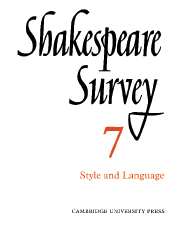Book contents
- Frontmatter
- Fifty Years of the Criticism of Shakespeare’s Style: A Retrospect
- Shakespeare and Elizabethan English
- The Poet and the Player
- Shakespeare’s Orthography in Venus and Adonis and Some Early Quartos
- The New Way with Shakespeare’s Texts: An Introduction for Lay Readers. I. The Foundations
- The Red Bull Company and the Importunate Widow
- Vaulting the Rails
- Shakespeare and the Acting of Edward Alleyn
- The Birmingham Shakespeare Memorial Library
- Shakespeare’s Italy
- International Notes
- Shakespeare Productions in the United Kingdom: 1952
- Acting Shakespeare: Modern Tendencies in Playing and Production
- The Year's Contributions to Shakespearian Study 1 Critical Studies
- 2 Shakespeare’s Life, Times and Stage
- 3 Textual Studies
- Books Received
- Index
- Plate Section
Vaulting the Rails
Published online by Cambridge University Press: 28 March 2007
- Frontmatter
- Fifty Years of the Criticism of Shakespeare’s Style: A Retrospect
- Shakespeare and Elizabethan English
- The Poet and the Player
- Shakespeare’s Orthography in Venus and Adonis and Some Early Quartos
- The New Way with Shakespeare’s Texts: An Introduction for Lay Readers. I. The Foundations
- The Red Bull Company and the Importunate Widow
- Vaulting the Rails
- Shakespeare and the Acting of Edward Alleyn
- The Birmingham Shakespeare Memorial Library
- Shakespeare’s Italy
- International Notes
- Shakespeare Productions in the United Kingdom: 1952
- Acting Shakespeare: Modern Tendencies in Playing and Production
- The Year's Contributions to Shakespearian Study 1 Critical Studies
- 2 Shakespeare’s Life, Times and Stage
- 3 Textual Studies
- Books Received
- Index
- Plate Section
Summary
In Thomas Middleton’s Black Book, Lucifer, “as Prologue to his own Play”,
…vaulted up so high
Above the stage-rails of this earthen globe,
to ascend “this dusty theatre of the world”. Remembering the ‘vaulting’ Herods and Lucifers of Miracle tradition, readers of Elizabethan drama must have often wondered whether in Shakespeare’s time players ever stepped beyond the confines of their platform stages, or whether the stage-rails constituted a frail but sure barrier between the demesnes of actor and audience, a sacrosanct frontier between two inviolable territories, like the line of footlights on the modern ‘picture’ stage.
A clear case can, I think, be made out for some continuity of tradition and convention between the Miracle and Elizabethan theatres in these matters: gesture, delivery, contemporary costuming, sound and light effects, machinery, affection for gruesome properties, spectacles, music, songs and dancing, soliloquies and asides, 'simultaneous' setting, trapwork, unlocalized settings, attitude to the Unities, fusion of the Tragic and Comic, and other aspects of production. It is clear too that the two theatres shared the same basic tradition of intimacy between actor and audience.
- Type
- Chapter
- Information
- Shakespeare Survey , pp. 69 - 81Publisher: Cambridge University PressPrint publication year: 1954
- 12
- Cited by

